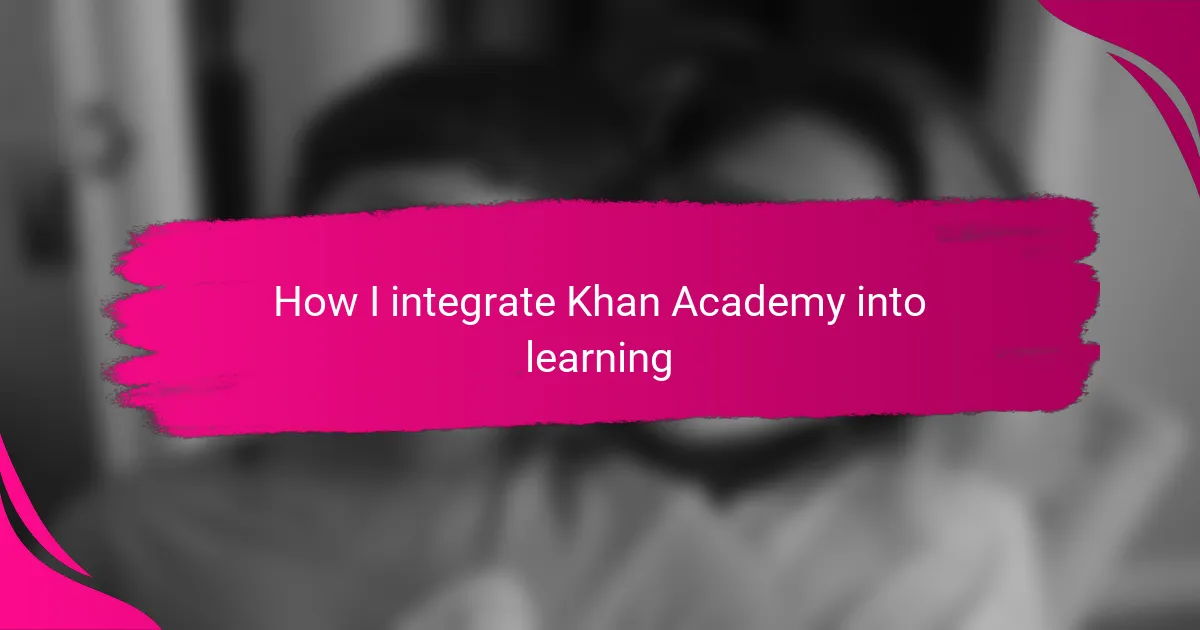Key takeaways
- Khan Academy offers free, high-quality educational resources that cater to children’s individual learning paces and needs.
- The platform’s user-friendly interface allows parents to track progress easily, encouraging a supportive learning environment.
- Integrating Khan Academy with schoolwork reinforces classroom learning and builds confidence in students.
- Positive reinforcement and consistent routines enhance motivation and foster a love for learning.
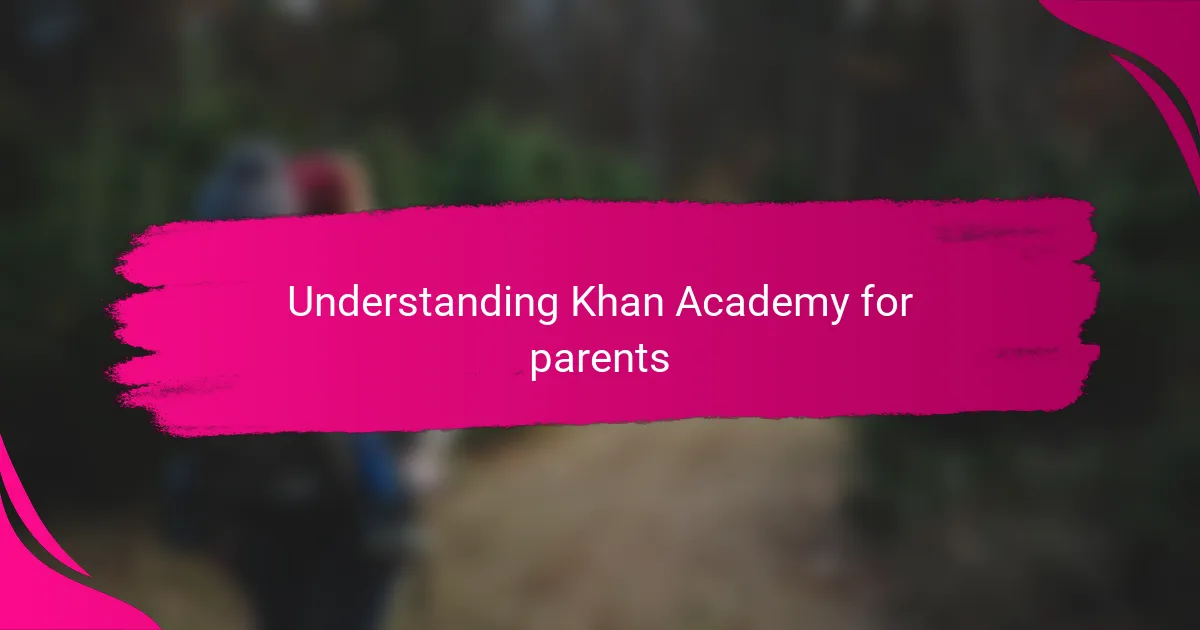
Understanding Khan Academy for parents
Khan Academy is more than just a website; it’s a treasure trove of free, high-quality educational videos and exercises across a wide range of subjects. When I first explored it, I was amazed by how accessible and clear the explanations were—it felt like having a patient tutor at home, ready whenever my child needed help. Have you ever wished for an extra set of hands to support your child’s learning? This platform fills that role beautifully.
One thing I appreciate as a parent is how Khan Academy allows me to track my child’s progress without feeling overwhelmed. The detailed dashboard shows what topics they’ve mastered and where they might need extra practice. It’s reassuring to have this insight, especially when trying to balance homework support with other parenting duties.
Understanding the platform’s design helped me see why it works for so many families. The bite-sized lessons fit perfectly into busy schedules, and the interactive exercises keep my child engaged. I often find myself thinking, why didn’t we have resources like this when we were kids? It’s a game-changer in making learning approachable and stress-free.

Benefits of Khan Academy in learning
One of the biggest benefits I’ve noticed with Khan Academy is how it tailors learning to my child’s pace. Instead of feeling rushed or left behind in a classroom setting, my child can pause and replay lessons until the concept really clicks. Have you experienced that frustration when your child struggles with a topic and you can’t find the right way to explain it? Khan Academy solves that by offering clear, step-by-step videos that feel like a calm, patient guide.
Another thing I truly value is how Khan Academy makes complicated subjects less intimidating. Math used to be a tough sell at home, but the visual examples and interactive quizzes change the game. It’s rewarding to see my child light up when they suddenly understand a tricky problem—those moments of confidence build so much motivation for learning.
Lastly, the free access to such a rich resource lifts a huge weight off my shoulders as a parent. I don’t have to worry about costly tutors or extra classes; everything we need is at our fingertips anytime, anywhere. Have you noticed how having that flexibility reduces stress not only for the child but also for the whole family? For me, that peace of mind is priceless.
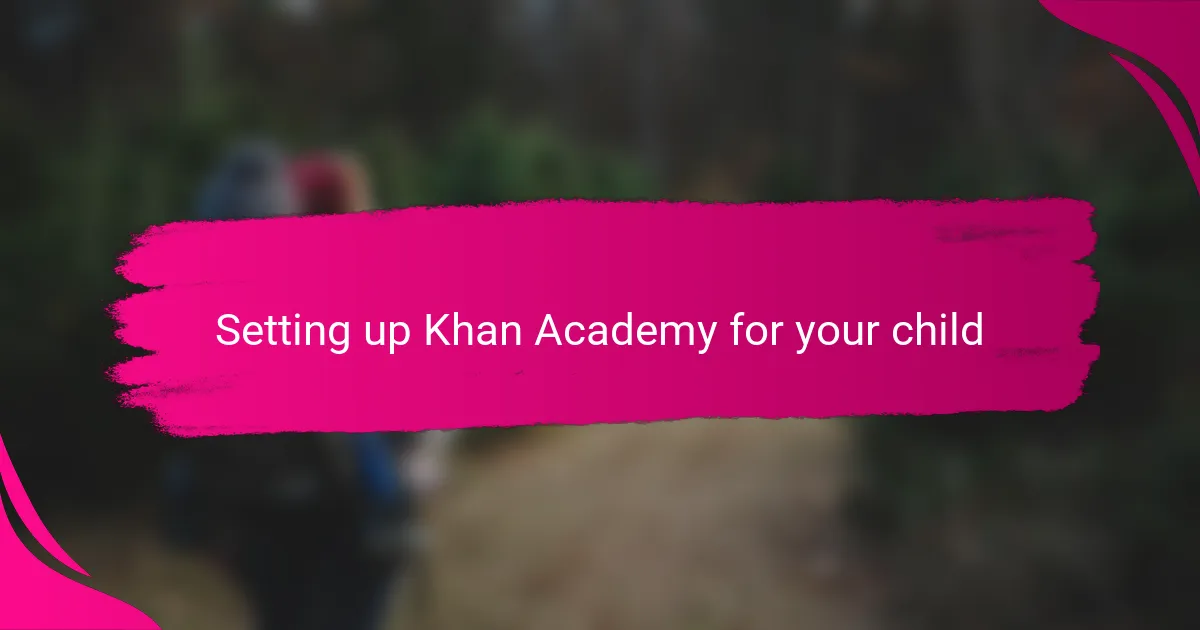
Setting up Khan Academy for your child
Setting up Khan Academy for your child is simpler than you might think. When I first created my child’s account, I appreciated how user-friendly the sign-up process was—it only took a few minutes, and I was able to personalize the learning paths right away based on their grade level and interests. Have you ever spent hours trying to navigate complicated educational sites? Khan Academy spares you that frustration with its straightforward setup.
Connecting the platform to your child’s daily routine makes a huge difference. I remember setting specific times for Khan Academy sessions after school, which helped my child anticipate learning without it feeling like a chore. The ability to bookmark lessons and track mastery keeps both of us motivated and on the same page about progress.
Adjusting the settings to match your child’s pace is a game-changer in making the experience truly their own. I found that tweaking notifications for completed exercises encouraged my child without overwhelming them. Have you noticed how small incentives and clear goals boost your child’s confidence? Khan Academy’s flexible setup supports this perfectly.
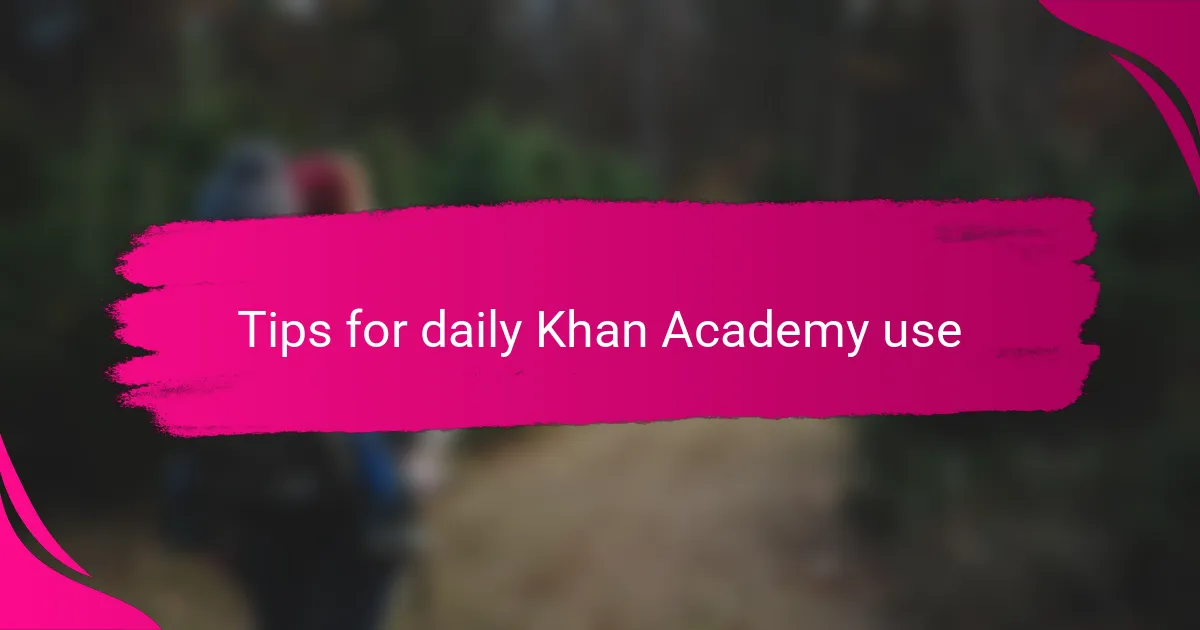
Tips for daily Khan Academy use
One tip I’ve found really helps with daily Khan Academy use is to set a consistent, manageable time each day for lessons. When my child knew there was a specific, predictable window for their learning, it felt less like a daunting task and more like a natural part of the day. Have you tried creating a little routine that sparks anticipation rather than resistance? That steady rhythm can turn quick lessons into lasting habits.
Another trick I swear by is to celebrate small wins together. Whenever my child masters a topic, even something as simple as a math skill, we take a moment to cheer it on. Those little celebrations build motivation and make the platform feel more rewarding than just another assignment. Isn’t it amazing how positive reinforcement transforms learning from a chore into an achievement?
Lastly, I recommend encouraging your child to use the practice exercises right after watching a video. It’s tempting to skip straight to the answers, but working through problems while the concept is fresh really deepens understanding. I’ve noticed that this immediate application helps my child connect the dots faster and feel more confident moving forward. Have you noticed how solving problems yourself sticks better than passive watching? Khan Academy’s design really supports this learning flow beautifully.
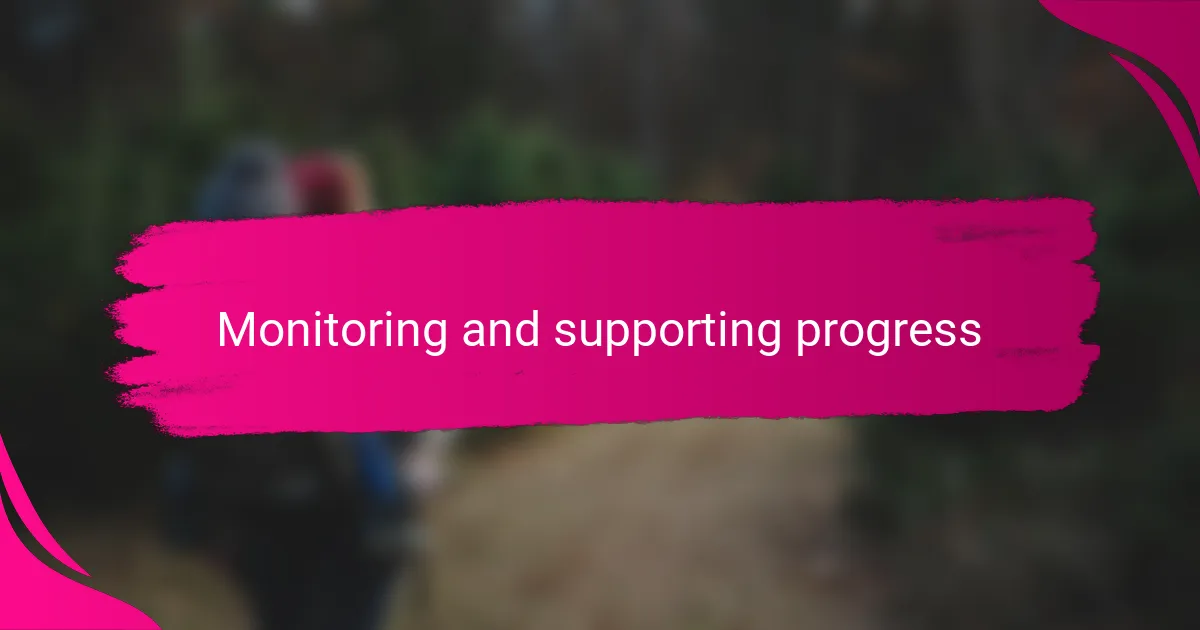
Monitoring and supporting progress
Keeping an eye on progress is essential, but I’ve found the key is doing it without turning learning into a pressure cooker. When I check my child’s Khan Academy dashboard, I focus on celebrating improvements rather than fixating on mistakes. Have you ever noticed how a simple “You’re doing great!” can spark more enthusiasm than constant corrections? That positive boost makes all the difference.
Supporting progress also means stepping in at the right moments. I try to be available when my child hits a snag—sometimes just sitting together and talking through a problem helps more than any explanation. Does your child respond better to gentle guidance or a bit of encouragement? Finding that balance has helped me turn frustrating moments into productive ones.
Finally, I like to use Khan Academy’s progress reports as a conversation starter, not a report card. Instead of asking “Why didn’t you get this right?” I ask, “What part was tricky here?” This approach opens up dialogue and shows my child that it’s okay to struggle—that learning is a journey. Have you found that this mindset helps your child stay curious rather than discouraged? For me, it’s been a game-changer in keeping motivation high.
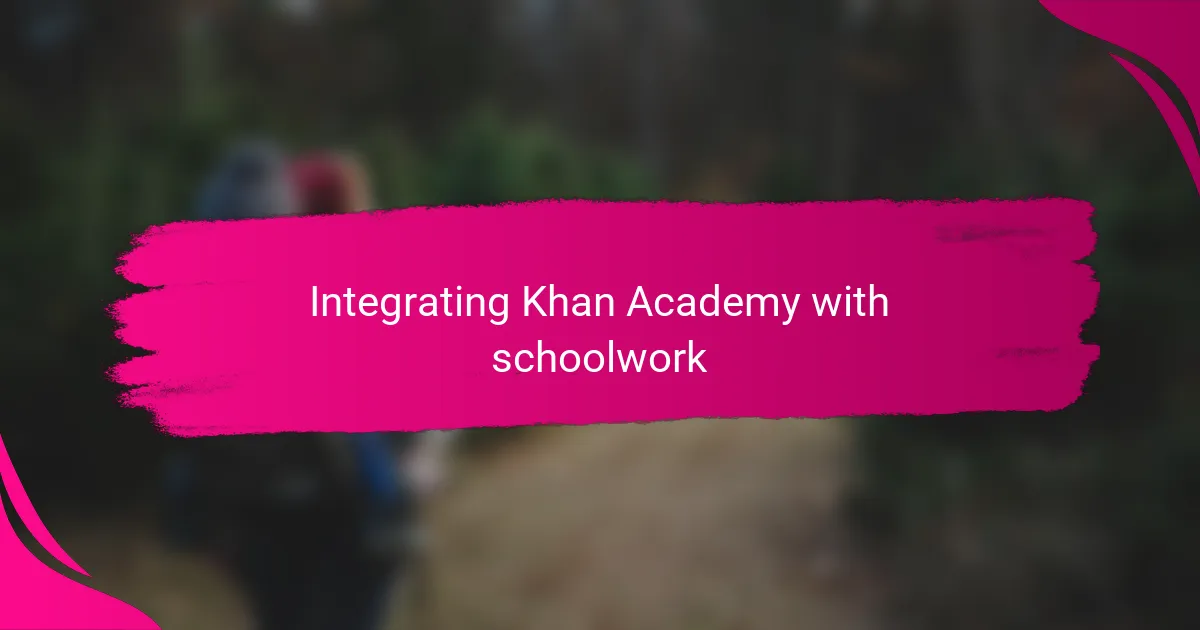
Integrating Khan Academy with schoolwork
Integrating Khan Academy with schoolwork has been a practical way for me to reinforce what my child learns in class. I often ask my child to watch the corresponding Khan Academy videos before tackling homework problems—it’s like previewing the material together, which makes the actual assignments less intimidating. Have you tried linking online lessons directly to school topics? It really bridges the gap between classroom pace and home learning.
Sometimes, I find that Khan Academy fills in the blanks when the school curriculum moves too quickly. When my child struggled with a math concept at school, revisiting the Khan Academy module provided that extra time and clarity needed to solidify understanding without pressure. Don’t you love it when your child gains confidence because they can learn at their own pace? That flexibility has been a real lifesaver in keeping frustration at bay.
I also like to encourage my child to use Khan Academy for review before tests or quizzes. Reviewing through the platform’s quizzes and practice exercises not only reinforces knowledge but also reveals exactly where they might need more focus. Have you noticed how this targeted practice can boost performance and reduce test anxiety? From my experience, integrating Khan Academy directly with schoolwork creates a smoother, more supportive learning environment at home.
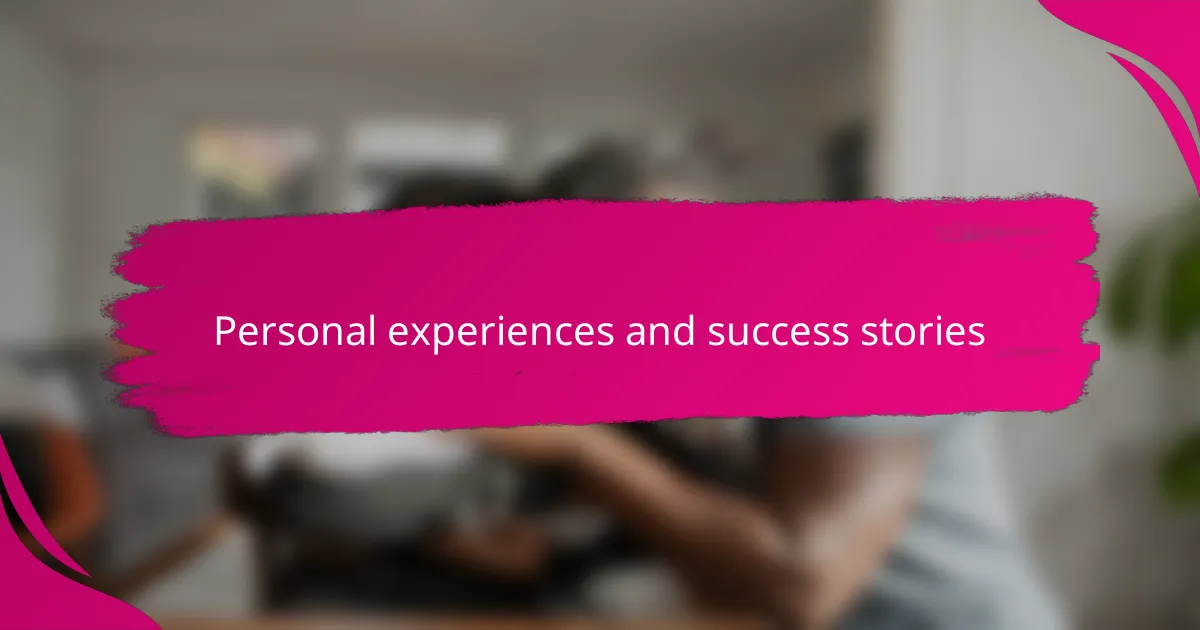
Personal experiences and success stories
I remember one evening when my child finally conquered a math topic that had been a source of frustration for weeks. Watching their face light up with pride after completing the Khan Academy exercises made me realize how powerful this tool can be—not just for learning, but for building confidence. Have you ever witnessed that moment when a child’s struggle turns into success? It’s truly priceless.
There was also a time when I was skeptical about how much a free online resource could help, but seeing steady progress over months changed my mind completely. My child went from dreading math homework to eagerly asking for “just one more lesson.” That shift in attitude felt like a win not just in academics, but in fostering a positive mindset toward learning. Isn’t that what every parent hopes for?
Another success story that sticks with me is how Khan Academy became a bridge during remote school days. When regular lessons were disrupted, having this reliable platform kept my child engaged and on track. It offered structure and reassurance, which made those uncertain times a bit easier for both of us. Have you found that extra layer of support valuable when school routines change unexpectedly? For me, it was a lifeline.
